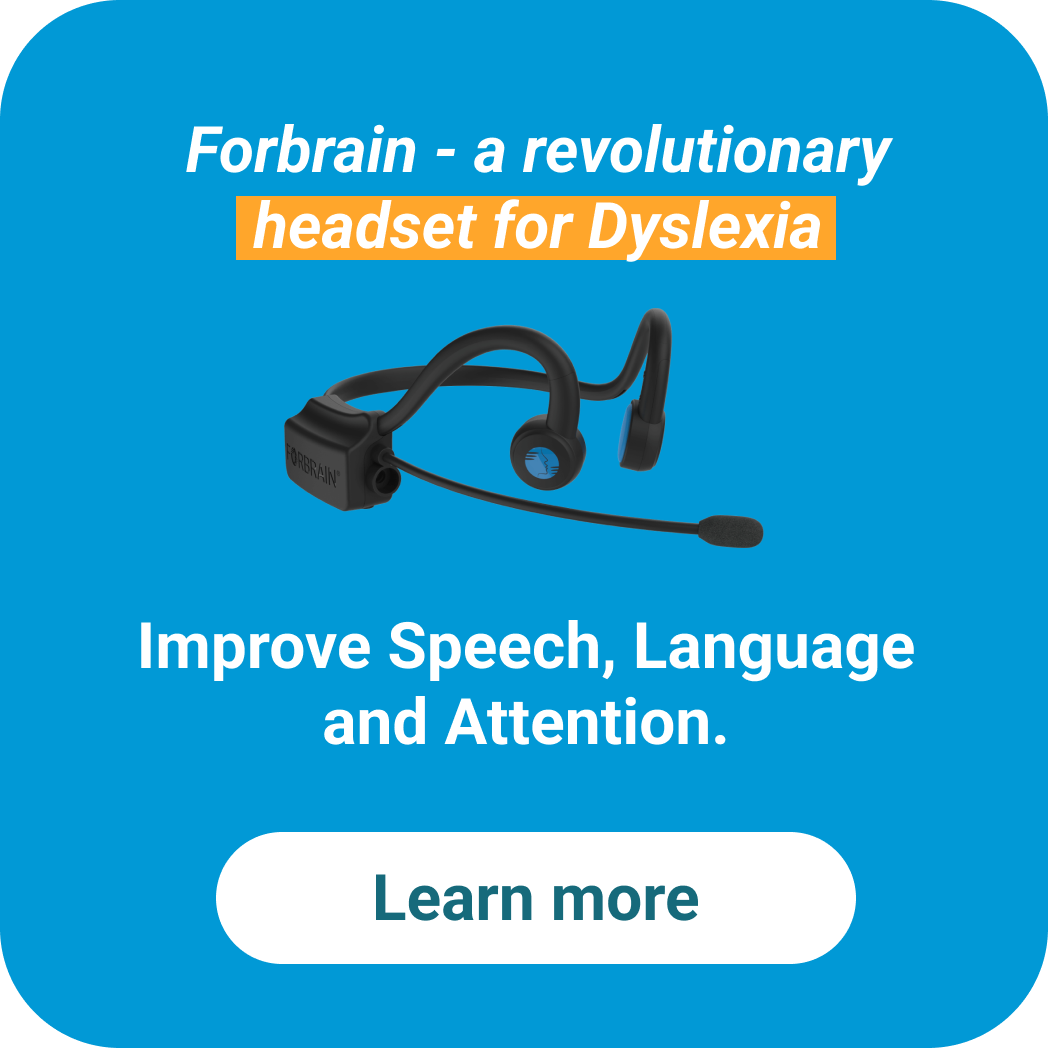Dyslexia and Reading Comprehension: Exploring Challenges and Strategies
 Charlotte Witts - October 04, 2023
Charlotte Witts - October 04, 2023 
What is Dyslexia | How Does Dyslexia Affect Reading Comprehension | Strategies for Improving Dyslexic Reading Comprehension | Using Forbrain
Has your child recently been diagnosed with dyslexia?
Perhaps you’re feeling relieved and can now understand why they’ve struggled so much to learn to read. It’s not that they lack intelligence or simply aren’t trying but have a neurological condition that affects language processing.
If you’re a parent or guardian of a child with dyslexia, you’re likely concerned about what the future might hold and how you can help your child build their confidence, improve their reading skills and reading comprehension and fulfil their potential.
The good news is that with the right support, you can do exactly this.
In this article, we’ll be explaining what dyslexia is, how it makes reading comprehension harder and what approach you can take to help them overcome these challenges.
What is Dyslexia?
Dyslexia is a common learning difficulty that affects a person’s ability to read and their reading comprehension. According to the International Dyslexia Association, it affects around 15-20% of the population and makes it harder for people to read at a good pace without mistakes, understand a text, spell and write.
Dyslexic children and adults often read slowly and make mistakes. However, when other people read to them, they have no problem understanding. This again highlights the fact that dyslexia isn’t a lack of intelligence but a difference in language processing.
If you suspect that your child has dyslexia, we recommend you get a formal assessment so you can get your child the help they need.
How Does Dyslexia Affect Reading Comprehension?
Dyslexia makes reading comprehension more difficult because of how the brain processes written language.
It might surprise you to know that there’s no single part of the brain designed to decode written language. Unlike spoken language which is processed in certain parts of the brain such as Broca’s area, Wernicke’s area and the angular gyrus, there isn’t the same for written language.
Instead, we need to ‘repurpose’ parts of the brain designed for visual processing, language comprehension and speech production. This includes the temporoparietal cortex, inferior frontal cortex and occipitotemporal cortex. Each of these helps us to sound out words, recognize words by sight and comprehend what we are reading.
The brain of someone with dyslexia works differently when it comes to language processing. Some of the areas mentioned above are less active, whereas the interior frontal cortex is more active. This can make it much harder for the dyslexic person to learn to read and comprehend what they are reading.
Here are some of the most common challenges they face:
Difficulty with Phonological Processing and Word Recognition
People with dyslexia struggle to recognize and manipulate the sounds of language. This makes it harder to identify the sounds that form language, blend them together to form words, recognize words (even those frequently used words), sound them out and decode them.
Letter and Word Reversals
It’s common for dyslexic readers to struggle when making a connection between written letters and the sounds that they represent. This causes them to reverse both individual letters and the words themselves, leading to confusion and miscomprehension.
Slow and Laborious Reading
Given the challenges dyslexic readers face such as problems recognizing sounds, letters, and understanding the connection between the two, they may read at a much slower pace, lose the thread, and need to reread sections. This makes it much harder for the ADHD child to learn to read.
Comprehension Challenges
Because phonological processing and word recognition are harder for a person with dyslexia, it takes them more effort to decode the language. As a result, they’ll find it harder than their non-dyslexic peers to read a text, comprehend its meaning and learn from it.
Poor Vocabulary Knowledge
The struggles that dyslexics face when reading make it harder for them to acquire the ‘vocabulary bank’ they need. This means they won’t have the words they need to express themselves and can struggle to recognise words in the text itself.
Strategies for Improving Dyslexic Reading Comprehension
There’s a range of effective strategies and tools that can help your child with dyslexia to overcome their reading challenges, improve reading comprehension and help them fall in love with reading. Here they are.
Read Together
Whatever age your child is, make time to read every day. Encourage your child to sit next to the reader and follow along with the text so they can start or improve their word recognition skills and become more comfortable with phonological (sound) patterns. Over time, this will aid their solo reading skills, boost comprehension, and help them see reading as a pleasurable activity.
Use Visualization and Imagery
If you can help your dyslexic child create mental images and associate them with a text, they will be more likely to recognize words, better comprehend a text and retain information. Mentally visualizing what they are reading also makes it fun, enjoyable, and effective and can help dyslexic readers grasp complex concepts and make connections that boost overall literacy skills.
Try Audiobooks
Audiobooks can be an excellent tool to help dyslexic children and adults improve their reading comprehension when used with printed texts. They make it easier for dyslexics to engage with the text, recognize the words and comprehend what they are reading.
Whenever your child needs to read a text, look for the audiobook version and encourage them to listen while they read. By doing so, you’ll also boost their confidence and help spark their imagination.
Harness the Power of Assistive Technology
Tools like text-to-speech software and the Forbrain headset can help dyslexic readers to reduce the challenges associated with reading, promote independence, and help them better process and comprehend the language they are reading. This can include:
- Text-to-speech software: This assistive technology reads a text aloud for the dyslexic student, boosts comprehension and improves the reading experience.
- Dyslexia fonts: Some fonts are designed to make it easier for dyslexic readers to enjoy a text.
- eBooks and audiobooks: Kids with dyslexia can learn to read more easily when using ebooks and audiobooks. This allows the reader to adjust the font, font size and background colors and can deliver the reading material in an audio format for better comprehension.
- Forbrain headset: Our advanced technology enhances the dyslexic child’s perception of sound via its bone-conduction technology, helping them ‘make sense’ of language and improve their overall language skills.
- Interactive learning apps: There are many educational apps that can support reading and language skills in an interactive and multisensory way while encouraging them to have fun!
Learn with a Structured Phonics Program
Dyslexics should use a structured phonics program such as the specially designed Orton-Gillingham method when learning to read or improving their reading skills. This teaches the relationship between letters and sounds slowly and systematically to suit their unique language-processing skills.
Start with simple high-frequency words, gradually progress to more complex ones, and then add more traditional phonics instruction so your child can improve their decoding skills and grow confidence in their abilities.
Always go slowly, give them plenty of time to practice and use the patented Forbrain headset for extra support.
Experiment with Dyslexia-Friendly Fonts
If you or your child owns a Kindle, Kobo, or other e-reading device, you may have come across dyslexic fonts.
As the name suggests, these are designed to make it easier for those with dyslexia to read, improving speed, accuracy and reading comprehension. This is because they feature heavier or thicker strokes at the bottom, increased character spacing and modified certain letters to reduce the chance of letter reversals.
However, opinions are divided on whether this truly makes a difference for those with dyslexia. We suggest that you try for yourself and see if you can see any improvement.
The Benefits of Using Forbrain in Reading
Alongside the tips and tricks we’ve shared above, you can further boost your dyslexic child’s reading and reading comprehension skills by using our patented Forbrain auditory stimulation headset.
Comfortable and easy to use, it helps your dyslexic child hear their voice louder and more clearly, improving their phonological (sound) processing skills and enhancing their overall language skills.
With this technologically advanced headset, they can improve their language fluency, enhance their reading skills, and improve their reading comprehension while giving their confidence a well-deserved boost.
Invest in Forbrain, use it for just 10-20 minutes per day and you’ll soon see an improvement.
Dyslexia and Reading Comprehension FAQs
Do people with dyslexia have trouble with reading comprehension?
Yes, if a person has dyslexia, they may struggle with reading comprehension because of their difficulty processing language. They may misread words, add or miss words or have problems conjugating verbs.
How do dyslexics learn to read?
Your dyslexic child can learn to read more easily using a systematic phonics-based instruction program. Although this can be slow, it teaches learners to match letters to sounds until they can read fluently.
What does dyslexia look like when reading?
If you or your child has dyslexia, you may mix up letters in a word, blend them together or lose the spaces between them. This makes it harder to comprehend and remember what you have read.
Can I be dyslexic if I like reading?
Yes! Even if you or your child has dyslexia, you can fall in love with reading if you have the right support when learning to read.
Does dyslexia only affect reading?
No. Dyslexia can also affect concentration, communication, memory, organization, and timekeeping which can have an impact on everyday life.
How do dyslexics read?
Dyslexics often read more slowly and need to work harder to read and comprehend a book or text. They often mix up letters in words, blend them together, lose spaces and may need to reread passages multiple times.
Final Words
Dyslexia can make it more difficult for your child to learn to read and understand what they are reading.
However, by understanding how they process written language, using the right strategies and tools and providing plenty of love and support, you can improve their reading skills, help them grow in confidence and achieve success in life. Use the tips we shared here alongside the scientifically proven Forbrain headset for faster, longer-lasting results.
References
Patterson, M. (2011, April 3). The paradox of dyslexia: Slow reading, fast thinking. cropped-YSM-Wordmark-Only-Black-High-Res.png. https://www.yalescientific.org/2011/04/the-paradox-of-dyslexia-slow-reading-fast-thinking/
Dyslexia basics. International Dyslexia Association. (2020, March 10). https://dyslexiaida.org/dyslexia-basics/
Who can diagnose: Dyslexia the gift. Dyslexia the Gift | Davis Dyslexia Association International. (2023, September 29). Read more.
Ap, T. (2016, March 7). This is what reading is like if you have dyslexia. CNN. https://edition.cnn.com/2016/03/05/health/dyslexia-simulation/index.html
ScienceDaily. (2022, November 29). How the brain processes language. ScienceDaily. https://www.sciencedaily.com/releases/2022/11/221129112658.htm
Dyslexia and the brain. International Dyslexia Association. (2015, February 26). https://dyslexiaida.org/dyslexia-and-the-brain-fact-sheet/
Kwok, R. K. W., & Ellis, A. W. (2014, May 6). Visual word learning in adults with dyslexia. Frontiers in human neuroscience. https://www.ncbi.nlm.nih.gov/pmc/articles/PMC4018562/
British Dyslexia Association. (n.d.). Living with a dyslexic partner. Read more.





